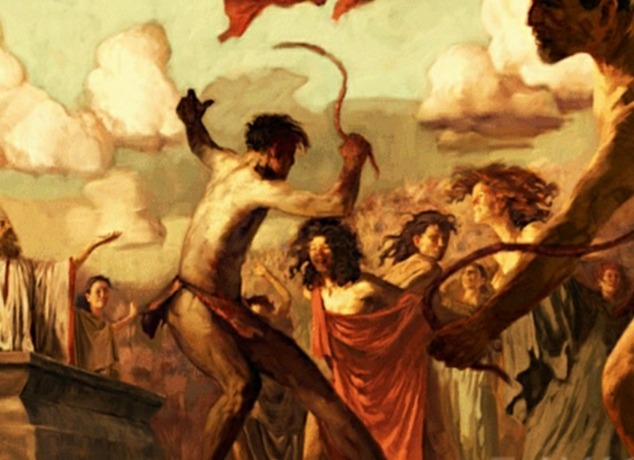You just finish putting away all the Christmas and winter decorations and Valentine’s Day rolls around, a time for the showy expression of love, especially romantic love, in the form of mushy cards, a box of chocolate, flowers, a romantic meal, maybe jewelry – you know what you have to do. But Valentine’s Day, formally St. Valentine’s Day, has weird ancient roots stained in blood and rites of spring.
Lupercalia
 Like many major Western holidays — Christmas, Easter, Halloween — Valentine’s Day has pre-Christian pagan roots, specifically in the ancient Roman celebration of Lupercalia, which was observed February 13-15 for over 1,000 years before being abolished at the end of the 5th century. Lupercalia was an odd blend of spring purification ritual, fertility rite, and tribute to Lupa, the she-wolf who suckled the infant orphans Romulus and Remus, the founders of Rome.
Like many major Western holidays — Christmas, Easter, Halloween — Valentine’s Day has pre-Christian pagan roots, specifically in the ancient Roman celebration of Lupercalia, which was observed February 13-15 for over 1,000 years before being abolished at the end of the 5th century. Lupercalia was an odd blend of spring purification ritual, fertility rite, and tribute to Lupa, the she-wolf who suckled the infant orphans Romulus and Remus, the founders of Rome.
The festivities began solemnly enough near Lupa’s cave on Palatine Hill, where Rome was traditionally founded, and were directed by the Luperci, the “brothers of the wolf,” who were priests of Faunus, the Roman equivalent of Pan. The festival got down to business with the sacrifice of two male goats for fertility and a dog for purity by the Luperci, who were each dressed only in a goatskin.
 Next, two young aristocratic Luperci were led to the altar and anointed with the sacrificial blood on their foreheads, which was wiped off the bloody knife with wool soaked in milk. A feast followed and then thongs were cut from the skin of the sacrificed animals and the Luperci, who were by then feeling quite festive, frolicked about the Palatine district.
Next, two young aristocratic Luperci were led to the altar and anointed with the sacrificial blood on their foreheads, which was wiped off the bloody knife with wool soaked in milk. A feast followed and then thongs were cut from the skin of the sacrificed animals and the Luperci, who were by then feeling quite festive, frolicked about the Palatine district.
In the 1st century, Greek historian Plutarch portrayed the scene. “Many of the noble youths and of the magistrates run up and down through the city naked, for sport and laughter striking those they meet with shaggy thongs,” he wrote. “And many women of rank also purposely get in their way, and like children at school present their hands to be struck, believing that the pregnant will thus be helped in delivery, and the barren to pregnancy.” Maybe a few of the lads took it upon themselves to help out with the latter, but one can only speculate.
By the 5th century, the festival had been abandoned to the “rabble” in what was by then Christian Rome, and was finally banned altogether at the end of the decade as an unseemly and licentious display. Not a lot of hearts and flowers per se, but the festival, at least originally, was a playful and flirty ode to fertility.
February 14 – A Day of Revelers and Martyrs
In one of those bizarre historical coincidences, the feast day of St. Valentine happened to be on February 14, the day the martyred 3rd century saint was executed. So you had a Christian commemoration that conflated with a defunct Roman rite of spring. Whether Lupercalia was a true precursor of Valentine’s Day as we now celebrate it is an open question, but it certainly laid some groundwork.
Life of Valentine(s)
Who was this Valentine, whose name is now synonymous with romantic love? And just to further muddy the waters, there were at least three saints from the early-Christian era named “Valentine,” “Valentinus” in Latin, two of whom were executed on a February 14 in the 3rd century!
By the 3rd century, the Roman Empire was on the wane, with civil pressures building from within and snarling barbarians threatening from without at every corner of the far-flung Empire, including Huns, Goths, and Vandals. Education and moral were down, taxes and corruption were up. The Empire had grown too large and unwieldy to control and protect with the military as it was, so emperor Claudius II, in an effort to shore up the forces, banned marriage for young men throughout the Empire. As legend has it, Claudius thought marriage made men weak, emotionally soft, and distracted from soldiering. According to legend, kindly Valentine was a bishop in the vicinity of Rome who sympathized with the plight of young lovers and agreed to marry them in secret in defiance of the emperor’s decree.
 Eventually Valentine was found out and jailed awaiting his ultimate punishment. As future saints tend to do, Valentine befriended his jailer, Asterius, who had a
Eventually Valentine was found out and jailed awaiting his ultimate punishment. As future saints tend to do, Valentine befriended his jailer, Asterius, who had a blind daughter, Julia. Valentine helped restore Julia’s sight and became close friends with her as well. When Claudius showed up to interrogate Valentine, he was impressed with the bishop’s manner and conviction, but when Valentine refused to consent to the marriage ban or to convert to Roman gods — in turn trying to convert Claudius to Christianity! — Claudius issued the execution order. As a final gesture of friendship, just before his execution Valentine wrote a farewell message to Julia, and signed it, “From Your Valentine.”
blind daughter, Julia. Valentine helped restore Julia’s sight and became close friends with her as well. When Claudius showed up to interrogate Valentine, he was impressed with the bishop’s manner and conviction, but when Valentine refused to consent to the marriage ban or to convert to Roman gods — in turn trying to convert Claudius to Christianity! — Claudius issued the execution order. As a final gesture of friendship, just before his execution Valentine wrote a farewell message to Julia, and signed it, “From Your Valentine.”
This last bit was added to the legend centuries after the fact and is almost certainly a little TOO romantic to be true. There is also no contemporary record of Claudius’ decree against marriage, so Valentine may have found a different way to annoy him, perhaps simply by being Christian, but you can’t keep a good story down.
Chaucer Invents Modern Valentine’s Day
There is no record of Valentine’s feast day being associated with romance until Geoffrey Chaucer’s poem The Parliament of Fowls in 1375, almost 900 years after the abolition of Lupercalia. In it, the Canterbury Tales author associates February 14 with the beginning of the mating season for birds, humans, and every other “species that men know.” “For this was on Saint Valentine’s day,” Chaucer wrote, “When every fow l comes there his mate to take, Of every species that men know, I say, And then so huge a crowd did they make, That earth and sea, and tree, and every lake, Was so full, that there was scarcely space, For me to stand, so full was all the place.”
l comes there his mate to take, Of every species that men know, I say, And then so huge a crowd did they make, That earth and sea, and tree, and every lake, Was so full, that there was scarcely space, For me to stand, so full was all the place.”
That’s a lot of responsibility for one busy saint!
St. Valentine, like his holiday, is spread around the world. The saint has his beflowered skull on display in Rome, and bits and pieces of himself in reliquaries in Czech Republic, Ireland, Scotland, England, and France. And while his mortal remnants may be scattered hither and yon, Valentine has to totally keep it together in the afterlife as a saint, responsible for keeping watch over lovers, beekeepers, epileptics, travelers, and victims of the plague. He is also the patron saint of engaged couples and happy marriages, naturally.











Share This
Share this post with your friends!